Catheter Care FAQs
Find your care
Trust our world-renowned prostate cancer experts to deliver your care.
For more information, connect with a prostate cancer care specialist at 310-794-7700.
Urinary Catheter Care and Prostate Cancer Treatment
Affiliated: Catheter Care
The following information is based on the general experiences of many prostate cancer patients. Your experience may be different. If you have any questions about what prostate cancer treatment services are covered by your health insurance, please contact your health care provider or health insurance provider. This education material was made possible by a Grant from the California Department of Justice, Antitrust Law Section, from litigation settlement funds to benefit Californians diagnosed with cancer or their families.
- What Will I Learn By Reading This?
- What Are A Urinary Catheter And What Are Urine Collection Bag?
- Why Might I Need A Urinary Catheter?
- How Long Will I Have A Urinary Catheter?
- How Can I Help Myself While I Have A Urinary Catheter?
- How Do I Clean My Urinary Catheter?
- How Do I Use A Leg Bag?
- How Do I Use A Night Drainage Bag?
- How Do I Clean My Urinary Collection Bags?
- How Do I Fix Problems With My Urinary Catheter?
- How Will My Urinary Catheter Feel?
- Are There Side Effects From Having A Urinary Catheter?
- When Should I Call My Doctor?
- What Happens When My Urinary Catheter Is Taken Out?
- What Have I Learned By Reading This?
- Glossary: Catheter Care
What Will I Learn By Reading This?
When you have prostate cancer you may need a urinary catheter to help your bladder or urethra heal or to help lessen the side effects (or unwanted changes in your body) from treatment. It is very common for men with prostate cancer to need a urinary catheter at some point during or after their treatment. You will learn about the following:
- What a urinary catheter is
- Why you may need a urinary catheter
- What are the different kinds of urine collection bags
- What are some possible side effects of a urinary catheter
- How you can take care of yourself when you have a urinary catheter
It is important for you to think about and plan how you will take care of yourself before and after your prostate cancer treatment so that you can keep doing as many of your normal activities as possible.
What Are A Urinary Catheter And What Are Urine Collection Bag?
A urinary catheter is a thin, flexible rubber tube placed in your body to drain urine from your bladder out through your penis. Your bladder is a muscle shaped like a balloon and holds your urine. On one end of the catheter is a small balloon. This balloon is filled with water so that your catheter is safely held in your bladder. The other end of the catheter is connected to a urine collection bag. There are two kinds of urine collection bags. The smaller collection bag is called a leg bag. It is attached to your leg with a pair of leg band straps during the day. This will help you move around easily. The bag can be worn under a loose fitting pair of pants. No one will know that you have a catheter. The large urine collection bag is called a night drainage bag and it should be used while you are in bed.
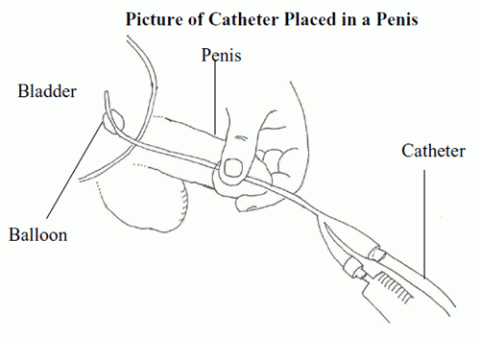
Why Might I Need A Urinary Catheter?
To help you understand why you might need a urinary catheter, you need to learn how your bladder works. Your bladder holds urine until you have the need to urinate (pee). Urine flows out of the bladder, and leaves your body through your urethra. Your urethra is a tube that carries urine and semen through your penis to the outside of your body. Urination (peeing) happens when the muscles in the wall of your bladder tighten, forcing urine out of your bladder. As the muscles in your bladder tighten, the muscles around your urethra relax and let you urinate. The prostate gland surrounds the urethra. If your prostate is enlarged or you have had treatment for your prostate cancer you may need a urinary catheter. The catheter is used when you cannot urinate by yourself or when your bladder or urethra need time to heal. This may happen for a number of reasons, such as:
- Prostate enlargement. As a man’s prostate grows larger, it may press on the urethra. This can cause some men with prostate enlargement to have trouble with urination.
- Prostate cancer surgery. Sometimes after a radical prostatectomy (radi- cul pros-ta-tek-toe-me) men have a hard time controlling their urine. This is because the surgery area is close to your bladder and your urethra. The surgery may weaken the muscles that control your urine flow. Surgery may also hurt the nerves that help control your bladder. This is why you may leak urine or are not able to control your urine after your surgery. Not being able to control your urine is called incontinence.
- Radiation therapy. Radiation therapy may lower the amount of urine your bladder can hold. This may cause you to leak urine. It may also cause spasms in your bladder that forces your urine out.
- Narrowing of urethra. Both prostate cancer surgery and radiation therapy may create scar tissue around your urethra. Your body makes scar tissue as it heals. The scar tissue can cause your urethra to become narrower. This makes it harder for you to urinate. This is known as a urethral stricture (yoo-ree-thruhl strik-cher).
If you need a urinary catheter, your doctor or health care team will show you how to care for your urinary catheter.
How Long Will I Have A Urinary Catheter?
Your doctor and health care team will decide how long you need to have a catheter. For example, after prostate cancer surgery, most men will have a catheter for about two weeks.
How Can I Help Myself While I Have A Urinary Catheter?
There are many easy things you can do to help yourself while you have a urinary catheter. What you do can help you to:
- Be more comfortable
- Keep from getting a bladder or kidney infection
- Work with your doctor and health care team to help you get better
Some things you can do to help yourself when you have a urinary catheter are:
- Do not remove your urinary catheter. If you feel that your catheter is not working the right way, call your doctor or health care team. Do not let anyone remove your catheter except your doctor or a nurse in your doctor’s office. They will make sure that the catheter is taken out the right way so your urethra and bladder are not damaged.
- Keep your skin and catheter clean. Clean the skin around your catheter at least two times each day. Clean your skin and catheter after every bowel movement.
- Always wash your hands with soap and warm water before and after cleaning your catheter.
- Always keep your urine collection bag below the level of your bladder. Your bladder is at about the level of your waist. Keeping the bag below your bladder will help keep your urine from flowing back into your bladder from urine collection bag. If your urine flows back into your bladder from your urine collection bag you may get an infection. An infection happens when germs enter your body causing you to have a fever or pain, redness, and swelling in one part of your body.
- Wear cotton underwear. This will allow good air flow and help keep your genital area dry. Your genital area is the part of your body that includes your penis, scrotum, perineum, and anus (rear end).
- Drink plenty of liquids. Drink at least eight glasses of healthy liquids or water each day unless your doctor or health care team gives you other directions. These liquids will help flush out your bladder. For most people, healthy liquids to drink are water, milk, and drinks that do not have caffeine. Caffeine may make you urinate (pee) too much and lose too much body fluid. Caffeine may be found in coffee, tea, soda pop, and sports drinks and foods. Try to drink enough liquid each day and not just when you feel thirsty.
- Do not have sexual intercourse (sex) while you have a catheter
- Try to keep from getting constipated. Constipation is when your bowel movements become less regular than normal and your stool is hard, dry, and difficult to pass. If you are constipated you may push hard when you have a bowel movement. This may cause you to leak urine. To help keep you from getting constipated:
- Make sure you drink enough healthy liquids. Most adults should drink at least eight glasses of water, milk, or drinks that do not have caffeine each day.
- Add more fiber to your diet. Eat more whole grains, such as bran muffins and cereals, wheat germ, and whole wheat bread, fresh fruits and vegetables, and prunes or prune juice.
- Do not take any over-the-counter medicines (medicines you buy without a prescription from your doctor) for your constipation without talking to your doctor or health care team.
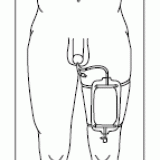
- Stay away from foods or drinks that will bother your bladder. Your bladder may become sensitive after a few days of wearing the catheter. It is best to stay away from foods and drinks that will bother your bladder more than it already is. Stay away from these foods and drinks:
• Acidic foods (Coffee and colas, for example)
• All alcoholic beverages.
• Carbonated drinks, especially colas
• Drinks with caffeine
• Chiles/Spicy foods, especially HOT ones
• Chocolate
• Coffee
• Cranberry Juice and/or Cranberries
• Lemon juice - After your catheter is taken out you may drink and eat these foods again. Speak to your doctor or health care team if you have any questions about your diet.
- Do not tug or pull on your catheter tubing. This can cause you to bleed and hurt your urethra. Do not step on the tubing when you walk. Hold the tubing curled in your hand with the urine bag below your bladder when you walk. You may also want to clip or pin the catheter tubing to your clothing. If you use a safety pin to attach the tubing to your clothing be careful that you do not put the pin through the tubing.
- Place the catheter tubing so it does not kink or loop.
- If you have urine leakage. You may wrap gauze around the catheter where it enters your body if you have drainage or leakage. Make sure to change the gauze when it feels wet. If you urine leakage is heavy, call your doctor or health care team right away.
- Do not do Kegel (Key-gul) exercises while you have a urinary catheter. Kegel exercises strengthen the pelvic floor muscles, which support your bladder and bowel.
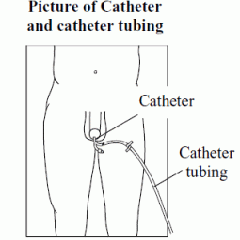
How Do I Clean My Urinary Catheter?
You need to wash your penis and the whole catheter tube gently with soap and warm water two times a day. It will be easier to remember to do this regularly if you plan to do it in the morning and before you go to bed at night. You may clean your penis and whole catheter tube this with warm soapy water and a wash cloth or in the shower. Do not take a tub bath while you have your catheter in place. It is important to keep your penis and the catheter clean so that you do not get an infection. Cleaning your catheter in the shower. When you take a shower to clean your catheter:
- Do not use very hot or cold water when you shower.
- Wash your penis and the catheter tubing very gently. Be careful not to pull or tug on the tubing.
Cleaning your skin and catheter out of the shower.
- Gather all the things you need to clean your skin and catheter.
a. Bowl of warm water, soap, washcloth, and hand towel.
b. Waterproof pad or bath towel. - Wash your hands. Use warm water and soap before and after cleaning your skin and catheter.
- Clean your catheter.
a. Hold the end of the catheter tube to keep it from being pulled while cleaning. Wash carefully around the catheter where it enters your body. - Clean the skin around your catheter.
a. Use a clean washcloth, warm water, and soap to gently wash your genital area. Wash in a circle-like motion, starting at the tip of your penis and moving back toward your anus (rear end). This helps prevent germs from being moved from your anus into your urethra.
b. Always wash the area around your anus last. Put the wash cloth into the laundry and do not use it again until it has been washed. Rinse and pat dry your genital area and catheter with a clean towel.
How Do I Use A Leg Bag?
If you are up and about, you'll want to use a leg bag to drain your urine. The bag is attached to the end of your catheter and is strapped to you’re your lower leg. Use the leg bag straps to hold the catheter tubing to your thigh (upper leg) and the bag to your lower leg. This will prevent the catheter from tugging and possibly being pulled out.
You should empty your leg bag every three to four hours or sooner if it is half full. To empty the leg bag:
- Wash your hands with soap and water.
- Stand or sit near a toilet or sink.
- Loosen the strap closest to your knee so that the bag hangs over the toilet.
- Remove the cap and open the clamp. Do not touch the drain port with your fingers or let the drain port touch the toilet seat.
- Drain the urine out of the leg bag.
- After the urine has drained out, wipe the drain port and cap with a cotton ball or gauze soaked with rubbing alcohol.
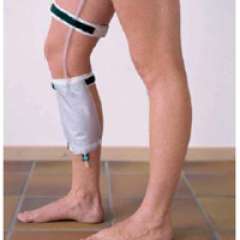
- Close the clamp and put the cap back on.
- Wash your hands with soap and water
To changing the leg bag to the night drainage bag:
- Wash your hands with soap and water
- Pinch the catheter tubing closed with your fingers.
- Remove the leg bag.
- Clean the tip of the night bag with a cotton ball or gauze soaked with rubbing alcohol. Connect the night bag to your catheter.
- Clean the leg bag following the directions in the section, “How do I clean my urine collection bags?”
- Wash your hands with soap and water.
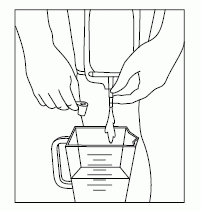
When you aren't using your leg bag, it should be washed out with soap and water and hung up to dry. This should be done once a day.
Plan For Cleaning Your Urinary Catheter
- When will you clean your catheter?
- What supplies do you need to clean your catheter?
How Do I Use A Night Drainage Bag?
The night drainage bag is larger than the leg bag and holds more urine. It is made to hang on the side of a bed or chair, or to be attached to any loose-fitting pants (such as sweat pants). The drainage bag may have hooks to fasten to your bed frame. If you are using a safety pin to fasten the catheter to your bed sheet or your clothing, make sure the safety pin goes around the catheter tube and not through it. Leave some slack in the tube so the catheter will not be pulled when you move your leg. You need to keep your urine collection bag below the level of your bladder. Whenever you are spending a lot of time lying down or sitting still, the night bag will work better. The night bag should always be used at night while you are sleeping. Do not put the bag on the floor. Before you go to sleep at night, you should change your leg bag to a night drainage bag.
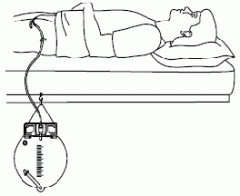
To use a night drainage bag:
- Wash your hands with soap and water.
- Empty your leg bag as explained in the section, “How Do I Use A Leg Bag?”
- Pinch the catheter tubing closed with your fingers.
- Remove the leg bag.
- Clean the tip of the night bag with a cotton ball or gauze soaked with rubbing alcohol. Connect the night bag to your catheter.
- Clean the leg bag following the directions in the section, “How do I clean my urine collection bags?”
- Wash your hands with soap and water.
- When you get into bed, arrange the tubing so that it does not kink or loop.
- Hang the night bag on the side of your bed. Be sure to keep the bag below the level of your bladder at all times.
To empty the night drainage bag:
- Wash your hands with soap and water.
- Stand or sit near a toilet or sink.
- Remove the cap and open the clamp. Do not touch the drain port with your fingers or let the drain port touch the toilet seat.
- Drain the urine out of the night bag.
- After the urine has drained out, wipe the drain port and cap with a cotton ball or gauze soaked with rubbing alcohol.
- Close the clamp and put the cap back on.
- Remove the night bag.
- Clean the tip of the leg bag with an alcohol swab.
- Attach the leg bag to the catheter tubing.
- Rinse out the night bag with soap and water, and hang it up to dry.
- Wash your hands with soap and water again.
When you aren't using your night bag, it should be washed out with soap and water and hung up to dry. This should be done once a day.
How Do I Clean My Urinary Collection Bags?
Just as it is important to clean your catheter tubing and penis each day to help lower your chance of getting an infection, it is important to clean your urine collection bag after each use. After changing your urine collection bag, you should clean the bag with soap and warm water. Then rinse completely. To make the urine collection bag as clean as possible, use:
- A mixture of white (distilled) vinegar and water. Do not use yellow (cider) vinegar. Mix 1 ¼ cup of white vinegar with 2 quarts of water. Rinse the bag well with this solution. Or,
- Mix a solution of 1 tablespoon of bleach to ½ a cup of water. Pour the bleach solution into the drainage bag. Rinse the bag well with this solution.
After you disinfect the bag, empty the bag. Do not rinse the bag with water. Hang the bag upside down and let it air dry. Wash your hands with soap and warm water. When the bag is dry, store it in a clean plastic bag until you are ready to use it again. Your leg and night drainage bags may be used for up to one month. After one month you will need new bags. Speak with your doctor or health care team about how to get new urine collection bags.
How Do I Fix Problems With My Urinary Catheter?
If you see that your catheter is not draining urine, check the following:
- Is the urine tubing twisted or bent? If it is, straighten out the tubing.
- Are you lying on the catheter tubing? If you are, move the tubing.
- Is the urine collection bag below the level of your bladder (waist level)? If it isn’t, lower the level of the urine collection bag until it is below the level of your bladder (waist level). If your urine is still not draining, call your doctor or health care team right away.
If your catheter is leaking:
- Place a towel or waterproof pad under you to protect your furniture.
- You may wrap gauze around the catheter where it enters your body if you have drainage or leakage. Make sure to change the gauze when it feels wet. It is ok if your catheter leaks a little. If you begin to leak a large amount of urine, call your doctor or health care team. If your catheter comes out, call your doctor or health care team right away.
Plan For Fixing Problems With Your Urinary Catheter
- What can you do if no urine is draining into your urine collection bag?
- What can you do if your catheter is leaking?
- If you have a problem with your catheter, when should you call your doctor or health care team?
Are There Side Effects From Having A Urinary Catheter?
Yes, there can be side effects or unwanted changes in your body when you use a urinary catheter. Side effects are different from person to person. Some people have no or very mild side effects. The good news is that there are ways to deal with most of the side effects. There are several side effects that you may have if you have a urinary catheter. They are bladder spasms, blood in your urine, and infections.
Bladder spasms. Sometimes, men have bladder spasms while the catheter is in their penis. Bladder spasms may feel like bad cramps or pains in the area above your pubic hair or in your rectum and can hurt. These spasms may be caused by the catheter bothering your bladder. If you have a bladder spasm, sometimes urine will leak around your catheter. If this happens you may want to put a towel on your bed to protect your mattress. Call your doctor or health care team right away if you start having bladder spasms. Your doctor can give you medicine that will stop the spasms. When the catheter is taken out, the bladder spasms will stop.
Blood in your urine. It is normal for the urine draining from your catheter to have some small blood clots. This is very common if you have had prostate cancer surgery. Blood clots are made when blood cells in your body join together to form a mass. Your urine can also become blood-tinged from time to time. When your urine is blood-tinged, it has a pinkish color. It is important to call your doctor or health care team if you notice more blood in your urine or if you see larger sized blood clots in the urine. Some clots can block your catheter from draining. You should regularly check that urine is draining from the catheter into your urine collection bag. It is important for you to drink healthy liquids when you have a catheter. This will help flush out your bladder.
Urinary tract infections. Infections of the urinary tract are very common. An infection is when germs enter your body causing you to have a fever or pain, redness, and swelling in one part of your body. To lower your risk of getting an infection:
- It is important that you clean the skin around your catheter tubing and your catheter at least two times each day.
- Keep your urine collection bag below your bladder (waist level).
Keeping the bag below your bladder will help keep your urine from flowing back into your bladder from the urine collection bag. If your urine flows back into your bladder from your urine collection bag you may get an infection.
How Will My Urinary Catheter Feel?
The end of your penis where the catheter comes out may not feel comfortable. Make sure to be gentle when washing the end of your penis. You may have been given leg straps. Use the leg straps to help keep your catheter from moving too much. This will lessen your discomfort. If the tip of your penis gets sore, try applying some water-based lubricant, such as plain K-Y Jelly, to keep the catheter from sticking to the tip of your penis. If this does not work, call your doctor or health care team. Your doctor or health care team will be able to give you other helpful suggestions. Do not use any other lotion, cream, or ointment on the tip of your penis before talking to your doctor or health care team.
When Should I Call My Doctor?
You should call your doctor if you have:
- No urine flows into your collection bag over a period of four hours and your catheter is not kinked
- No urine flows into your bag over a couple of hours, and you feel like your bladder is full
You should also call your doctor if you have:
- A fever over 101° F (38.3° C) or chills
- Pain or a burning sensation in your urethra, bladder, abdomen, or lower back
- Bladder spasms
- Blood, mucus, pus, or foul smelling drainage around your catheter
- Urine leaking around your catheter
- Soreness at the tip of your penis that isn’t better after using plain KY jelly
- Urine that becomes cloudy or foul smelling
- Urine that has mucus, red specks, or blood in it. Urine with blood in it may appear pink or red
- Any symptoms (signs of being sick) that you are concerned about
- Any other warning signs mentioned by your doctor or health care team
If you have any of these signs talk to your doctor or health care team. There are medicines and treatments that can help you feel better. It is important that you talk to your doctor or health care team about any side effects you may have during or after your treatment. Your health care team can help treat these problems.
What Happens When My Urinary Catheter Is Taken Out?
The day your catheter is taken out is a big step forward in your recovery. Taking out your catheter will only take a couple of seconds and is not painful. You may feel a slight tug or a pulling feeling as it comes out, but it does not hurt. You will probably feel very relieved to no longer have your catheter.
When your catheter is removed, you will probably leak or pass urine when you don’t want to. This is called incontinence. Remember to bring an incontinence pad, like Depends, with you to the doctor’s office or clinic. Being unable to control your urine after your catheter is taken out is normal. This should get better over time. There are also exercises, called Kegel Exercises, which you can do to make the muscles that control your urine flow stronger. For more information, please see the IMPACT booklet, “Kegel Exercises for Men.” Your doctor or health care team can also give your information on how to do these exercises.
What Have I Learned By Reading This?
You learned about:
- What a urinary catheter is
- Why you may need a catheter
- How to care for your urine collection bags
- What are some possible side effects of a urinary catheter
- How you can take care of yourself when you have a urinary catheter
If you have any questions, please talk to your doctor or health care team. It is important that you understand what is going on with your treatment. This knowledge will help you take better care of yourself and feel more in control so that you can get the most from your treatment.
Glossary: Catheter Care
- Abdomen: the part of your body above and around your belly button.
- Anus: the opening in your body through which stool passes. Your rear end.
- Bladder spasms: feel like bad cramps or pains in the area above your pubic hair or in your rectum and can hurt.
- Bladder: the organ in your body that holds your urine until you urinate (pee).
- Blood clot: a mass formed when the blood cells in your body join together.
- Blood-tinged urine: Urine with a pinkish color.
- Constipation: when your bowel movements become less regular than normal and your stool is hard, dry, and difficult to pass.
- Drain port: the part urine collection bag which allows you to empty urine (pee) from the bag.
- Genital area: the part of your body that includes your penis, scrotum, perineum, and anus.
- Incontinence: the unwanted leaking of urine.
- Incontinence pads: items used to protect clothing from urine leakage.
- Infection: when germs enter your body causing you to have a fever or pain, redness, and swelling in one part of your body.
- Intercourse: the act of having sex.
- Kegel exercises: Exercises to strengthen the pelvic floor muscles and support your bladder.
- K-Y Jelly [Plain]: a brand of water-based lubricant available at any drug store.
- Leg bag: Small plastic bag that collects urine from your catheter. This type of collection bag is worn on your lower leg while you are out of bed.
- Leg bag straps: A pair of latex bands used to attach the smaller collection bag to your leg.
- Night drainage bag: Larger plastic bag that collects urine from your catheter. This type of collection bag is used during the night while you are in bed.
- Over-the-counter: medicines you buy without a prescription from your doctor.
- PC muscles (also known as Pelvic floor or pubococcygeus muscles): muscles that support your bladder and rectum and helps control your urine flow.
- Pelvic floor muscles (also known as the pubococcygeus (pu-bo-kak-sij-e) or
- PC muscles): muscles that support your bladder and rectum and helps control your urine flow.
- Prostate enlargement: a swelling of the prostate gland which makes urinating more difficult by narrowing the urethra.
- pubococcygeus (pu-bo-kak-sij-e) muscles (also known as pelvic floor or PC muscles): support your bladder and rectum and helps control your urine flow.
- Radiation therapy: a cancer treatment that uses high energy beams, such as xrays, to kill cancer cells and to stop them from spreading.
- Radical prostatectomy (ra-di-cul pros-tatek-toe-me): an operation in which your surgeon takes out your entire prostate gland.
- Rectum: part of your body’s digestive system that stores waste until it leaves your body.
- Scar tissue: a thick layer of tissue made by your body as it heals.
- Side effects: unwanted changes in your body.
- Stool: the fecal matter that comes out at each movement of your bowels.
- Thigh: your upper leg
- Urethra: a tube that carries urine and semen through the penis to the outside of the body.
- Urethral ( yoo-ree-thruhl) stricture (strik-cher): when your urethra narrows making it hard for you to urinate (pee).
- Urinary catheter leg strap: A Velcro fastener strip applied to your upper leg that holds the catheter tubing and secures it in place.
- Urinary catheter: A thin, flexible rubber tube which is placed in your body to drain urine from your bladder out through your penis.
- Urinate: to pee.
- Urine collection bag: A plastic bag which attaches to your catheter to collect the urine draining from your bladder.